This Vietnamese chicken noodle soup, pho ga, is the chicken version of the more well-known beef pho (pho bo). You can make a fantastic bowl of Vietnamese chicken noodle soup with delicious broth and tender chicken in under thirty minutes using a pressure cooker. This pressure cooker pho ga recipe saved me time, as the typically lengthy process of making pho would require a few hours of simmering.

❓What is Phở?
Pho is a Vietnamese noodle soup dish with a flavorful broth, rice noodles, and meat toppings. It originated in northern Vietnam, was influenced by French and Chinese culinary traditions, and has become Vietnam’s national dish. The broth is made by simmering beef bones, spices, and sometimes chicken or beef for several hours. It has a rich, aromatic, and slightly sweet flavor. The rice noodles are called “banh pho” and have a soft, slightly chewy texture. Pho is often served with fresh basil, bean sprouts, lime wedges, and chili sauce on the side. There are regional variations in pho, and it has gained immense popularity worldwide.
Main ingredients to make pho ga (Vietnamese chicken noodle soup)
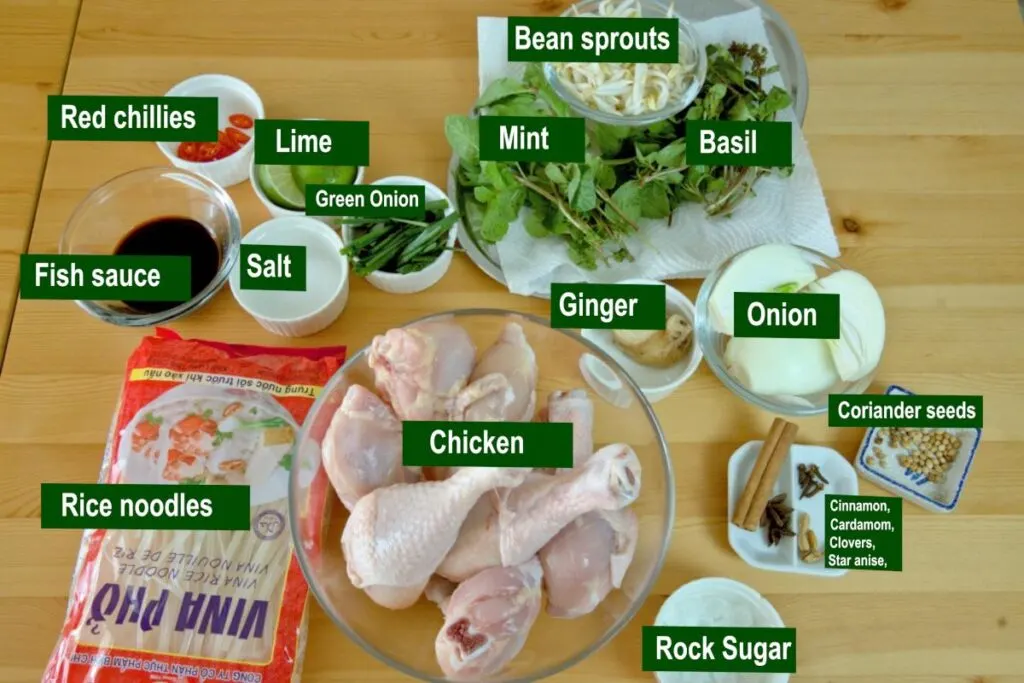
a. Chicken
Making chicken phở is best using whole chicken as it provides a rich and flavorful broth from a mix of bones, dark meat, and white meat. If the chicken comes with innards and neckbones, it’s best not to discard them and use them in the stock.
If you don’t have a whole chicken, you can use any available chicken pieces, such as wings, drumsticks, chicken thighs, and breasts. I use drumsticks today as it is flavorful and with bones.
b. Seasonings
I enjoy flavoring my phở with a blend of seasonings, mainly with rock sugar, salt, and fish sauce. You may consider adding MSG and chicken bouillon powder, but they are optional. I do not have these things at home, so I will leave them out. Rock sugar adds a touch of subtle sweetness, but regular granulated sugar can be used in a smaller amount if it’s unavailable.
Please season the phở broth generously with salt, as the broth’s saltiness will be balanced out once it’s combined with the rice noodles, chicken, and assorted vegetables.
c. The noodles
I dried Bánh Phở noodles to prepare the noodles today. These rice noodles need to be soaked and then boiled before use. Please refer to the instructions on the packaging, as they may differ from brand to brand due to the texture and thickness.
Alternatively, you can choose fresh rice noodles in the refrigerated aisle. These noodles have a semi-dry appearance and require a quick blanch before use. The fresh rice noodles for phở noodle soup have a better flavor than the dried ones. It’s best to cook these noodles before serving to avoid becoming soggy.
d. Fresh herbs
The verb platter I used consists of mint leaves, Thai basil, sliced spring onion, and bean sprouts. It’s best to add the herbs to your bowl of pho while eating. As for the bean sprouts, you can leave them raw for a crunchy texture or blanch them. Both ways are delicious and depend on your preference. Squeezing lime juice is recommended for a burst of citrus flavor.
📝 The step-by-step guide to making pressure cooker pho ga
Below is a detailed breakdown of preparing Vietnamese chicken noodle soup (pho ga) using a pressure cooker.
1. Brown the onion and ginger
For traditional pho, whether it’s the chicken version I’m making today or more complicated beef pho, the process begins with browning onions and fresh ginger until they are nearly black. This can be done either over the direct heat of a flame or in a pot. I prefer the broiler method, as it’s less messy and faster.
I place the ginger and shallots on a baking pan lined with aluminum foil and put it on the top rack of the oven to broil it with the broil setting for 20 minutes until slightly charred. Turn them once to ensure that all the sides are evenly blackened.
The final method, which is also the fastest, is to hold the onions and the ginger using tongs over the gas stove. Please use a small flame, or they will burn quickly.
After charring, I peel and discard the blackened skins of the ginger and onions, then rinse the charred ingredients before adding them to the broth.
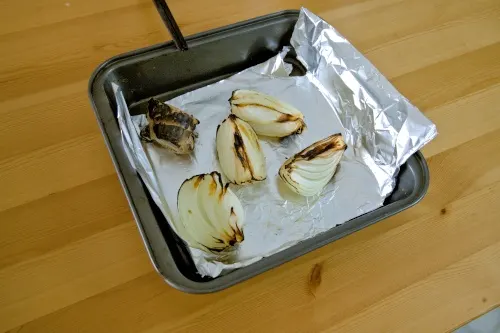
2. Roast the spices
To bring out the full flavor of the spices, I heat a saucepan over medium heat to roast the star anise, cinnamon stick, green cardamom pods, cloves, star anise, and coriander seeds until they become fragrant, which usually takes 3-5 minutes. Once aromatic, I transfer them to a small cloth bag so they can be removed from the broth easily after simmering. Toasting the spices enhances their flavor. It is crucial to elevate the broth to the next level.
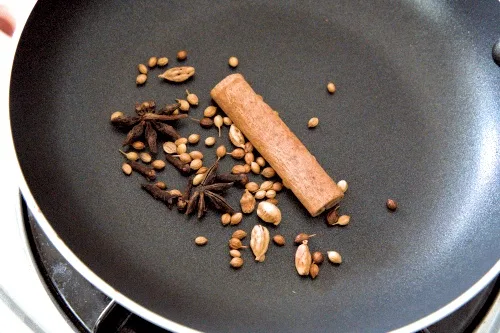
3. Pressure cook all the ingredients
Now, we come to the most essential part of preparing the pressure cooker pho ga- putting all the ingredients into the pressure cooker.
You may have noticed that I did not blanch the chicken. This is because I am not using a whole chicken, and I don’t think blanching the chicken will make a significant difference in taste and appearance. Furthermore, since I used the pressure cooking method, there will be less boiling involved in the process, and hence, there will be less cloudiness in the broth being made.
The process is pretty straightforward. Put the chicken, spices, onion, and ginger into the pressure cooker and season it with rock sugar and salt. I prefer to add the fish sauce later because it is easier to balance the flavor in the later stage.
After locking all the ingredients in the pressure cooker, start the pressure cooking for 20 minutes.
You may consider adding some MSG or chicken bouillon to enhance the taste, but it is optional. I do not keep all these ingredients at home, opting for healthier cooking. I would balance it with more fish sauce at a later stage.
Once the pressure cooking has finished and the pressure has been released, Remove the drumsticks from the pot first, as they can break easily. After that season, add the broth with fish sauce and salt, and possibly add some water to balance the taste.
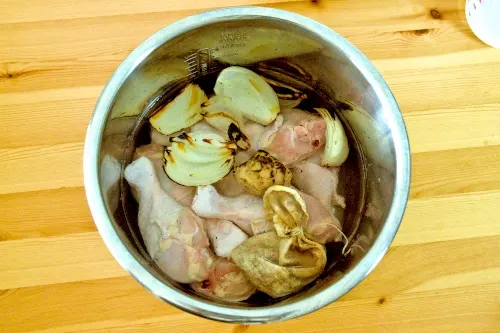
4. Pass through a strainer to get the clean broth
Next, remove all the ingredients and let the broth pass through a strainer. This is the easiest way to get a clean broth.
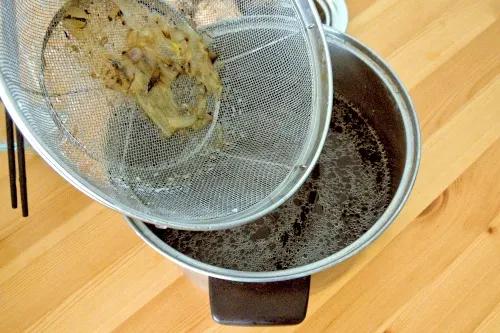
5. Blanch the noodles
To prepare the noodles, I follow the instructions on the package. I soak them until they’re soft, which usually takes about 20 minutes, and then blanch them in boiling water for five to 10 seconds, than ransfer the noodles to a serving bowl.
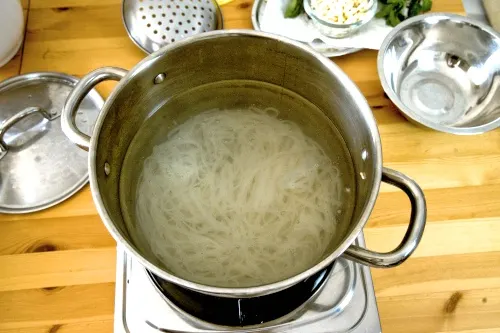
6. Prepare the herbs
The 20 minutes in the pressure cooker gave me the perfect window to prep the rice noodles, herbs, bean sprouts, onions, green onions, and limes.
My go-to selection of herbs is Thai basil, bean sprouts, and green onions. I might throw in some mint leaves if I have them on hand. When it comes to the bean sprouts, I usually briefly cook them in boiling water, but some people prefer to eat them raw.
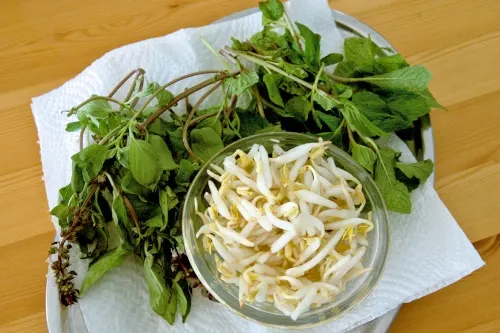
7. To serve
- Cook the noodles in boiling water until they are al dente. If you are using dried noodles, follow the instructions on the packaging. Then, place the noodles in a large bowl.
- Pour the hot broth into the bowl. Add the chicken meat and garnish with green onions and sliced red chili.
- Rinse the bean sprouts, Thai basil, and mint leaves. Cut a lime in half and place it on a plate with the herbs to serve alongside the hot bowl of noodles.
Note: For a better presentation, serving the whole drumstick is recommended. However, eating the chicken is easy if you debone it. Ultimately, the choice is yours.
Why do I use the electric pressure cooker to prepare Vietnamese chicken pho
Pressure cookers offer significant advantages while cooking pho broth. Firstly, the high pressure environment allows water to boil at a higher temperature, which speeds up the cooking process. For instance, a chicken leg can become tender in just 15 to 20 minutes, cutting the cooking time in half compared to traditional methods. Besides, since the liquids in a pressure cooker won’t boil at full pressure, you can make a clear broth without skimming. These benefits make pressure cookers a time-saving and efficient choice for busy cooks like me.
The difference between Vietnamese chicken and beef noodle soup
I must admit that Vietnamese Pho uses beef, which is more flavorful than chicken. However, I used chicken today because making the beef takes much longer. Due to that, I haven’t made the beef version in a long time. There’s a reason why I came up with the idea of making the chicken version using the pressure cooker. It is much more convenient, takes less time, and is easier to make.
📜 Other related recipes to Vietnamese chicken noodle soup
If you enjoyed this pressure cooker pho ga, you’ll likely enjoy other similar Asian noodle dishes. Here are some of my recommendations:
- Try this Vietnamese pork chop that only takes 30 minutes to prepare.
- Ipoh shredded chicken noodles offer a totally different taste from the pho ga. Here is how to make it.
- Pad Thai. If you love Thai food, try out this best street food recipe in Thailand.
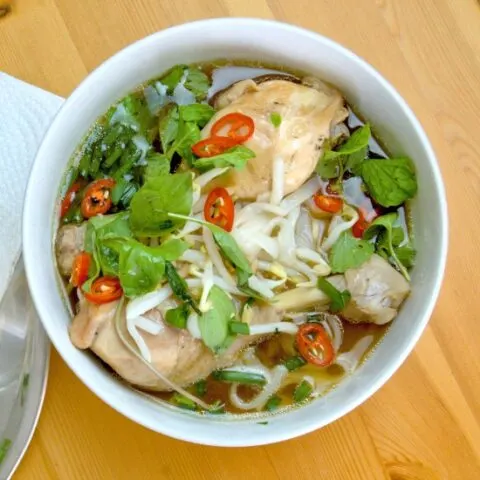
Pressure cooker pho ga- Vietnamese chicken noodle soup
Making Vietnamese pressure cooker pho (chicken noodle soup) is so satisfying because it's so easy and straightforward.
Ingredients
Ingredients A
- 2 medium-sized onions
- 2-inch ginger
- 1 cinnamon stick
- 4 cloves
- 4 cardamon
- 2 star anise
- 1 tsp coriander seeds
- 8 drumsticks
- 25g rock sugar
- 2.5 tsp salt
- 1.5 liter water
Ingredients B
- 200g dried rice noodles
- 5 tbsp fish sauce
- 1 handful of bean sprouts
- 1 tbsp green onions
- 1 tsp cut red chili
- Small bunch of mint leaves
- Small bunch of Thai basil leaves
- One lime
Instructions
- Place the ginger and shallots on a baking pan lined with aluminum foil and place it on the top rack of the oven to broil it for 20 minutes. Discard the blackened skins of the ginger and onions.
- Roast the star anise, cinnamon stick, green cardamom pods, cloves, star anise, and coriander seeds until they become fragrant.
- Put all the ingredients A into the pressure cooker.
- Use pressure cooking mode to cook for 20 minutes.
- Once the pressure cooking has finished and the pressure has been released, Remove the drumsticks. After that, season the broth with fish sauce.
- Remove all the ingredients and let the broth pass through a strainer.
- Prepare the noodles by following the instructions on the package.
- Pour the hot broth into the bowl. Add the chicken meat and garnish with green onions and sliced red chili. Serve along with the herbs on the side.
Recommended Products
As an Amazon Associate and member of other affiliate programs, I earn from qualifying purchases.
Nutrition Information:
Yield: 3 Serving Size: 1Amount Per Serving: Calories: 783Total Fat: 23gSaturated Fat: 6gTrans Fat: 0gUnsaturated Fat: 14gCholesterol: 308mgSodium: 4685mgCarbohydrates: 75gFiber: 4gSugar: 14gProtein: 66g
This data was provided and calculated by Nutritionix on 22/6/2022


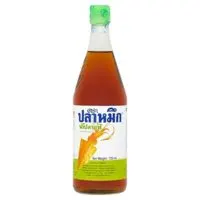
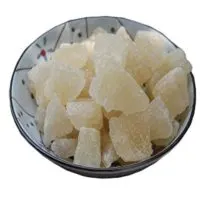
How to Make Perfect Chinese Glass Noodle Stir-fry
Thursday 5th of June 2025
[…] Pressure cooker pho ga […]
How to Make Beef Hor Fun Full of Wok Aroma 干炒牛河
Saturday 18th of January 2025
[…] Pressure cooker pho ga- Vietnamese chicken noodle soup […]
KP Kwan
Saturday 22nd of June 2024
Hi, this is KP Kwan. Thank you for reading my recipe. Please feel free to ask any questions or leave comments. I’ll respond as soon as possible.